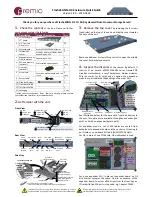
Installing a memory module
The following notes describe the types of dual inline memory modules (DIMMs) that
the server supports and other information that you must consider when you install
DIMMs (see “System-board internal connectors” on page 17).
v
The server supports industry-standard, 1066, 1333 and 1600 MHz, PC3-12800
(single-rank or dual-rank) double-data-rate 3 (DDR3), registered or unbuffered,
synchronous dynamic random-access memory (SDRAM) dual inline memory
modules (DIMMs) with error correcting code (ECC). For a list of supported
options for the server, see http://www.ibm.com/servers/eserver/serverproven/
compat/us/; then, select your country and navigate to the list of options for the
server.
v
The maximum amount of memory that the server supports is dependent on the
type of memory that you install in the server.
v
The amount of usable memory is reduced, depending on the system
configuration. A certain amount of memory must be reserved for system
resources. To view the total amount of installed memory and the amount of
configured memory, run the Setup utility. For additional information, see “Using
the Setup utility” on page 271.
v
The maximum operating speed of the server is determined by the slowest DIMM
in the server.
v
If you install a pair of DIMMs in DIMM connectors 1 and 3, the size and speed of
the DIMMs that you install in DIMM connectors 1 and 3 must match each other.
However, they do not have to be the same size and speed as the DIMMs that
are installed in DIMM connectors 2 and 4.
v
You can use compatible DIMMs from various manufacturers in the same pair.
v
When you install or remove DIMMs, the server configuration information
changes. When you restart the server, the system displays a message that
indicates that the memory configuration has changed.
Attention:
Static electricity that is released to internal server components when
the server is powered-on might cause the server to stop, which could result in
the loss of data. To avoid this potential problem, always use an
electrostatic-discharge wrist strap or other grounding system when working inside
the server with the power on.
v
The specifications of a DDR3 DIMM are on a label on the DIMM, in the following
format.
ggg e
Rx
ff
-PC3-
wwwwwm
-
aa
-
bb
-
cc
where:
ggg
is the total capacity of the DIMM (for example, 1GB, 2GB, or 4GB)
e
is the number of ranks
1 = single-rank
2 = dual-rank
4 = quad-rank
ff
is the device organization (bit width)
4 = x4 organization (4 DQ lines per SDRAM)
8 = x8 organization
16 = x16 organization
wwwww
is the DIMM bandwidth, in MBps
8500 = 8.53 GBps (PC3-1066 SDRAMs, 8-byte primary data bus)
10600 = 10.66 GBps (PC3-1333 SDRAMs, 8-byte primary data bus)
Chapter 5. Removing and replacing server components
203
Summary of Contents for System x3100 M4
Page 1: ...IBM System x3100 M4 Type 2582 Problem Determination and Service Guide...
Page 2: ......
Page 3: ...IBM System x3100 M4 Type 2582 Problem Determination and Service Guide...
Page 24: ...4 IBM System x3100 M4 Type 2582 Problem Determination and Service Guide...
Page 42: ...22 IBM System x3100 M4 Type 2582 Problem Determination and Service Guide...
Page 170: ...150 IBM System x3100 M4 Type 2582 Problem Determination and Service Guide...
Page 182: ...162 IBM System x3100 M4 Type 2582 Problem Determination and Service Guide...
Page 286: ...266 IBM System x3100 M4 Type 2582 Problem Determination and Service Guide...
Page 316: ...296 IBM System x3100 M4 Type 2582 Problem Determination and Service Guide...
Page 324: ...304 IBM System x3100 M4 Type 2582 Problem Determination and Service Guide...
Page 331: ......
Page 332: ...Part Number 00V9701 Printed in USA 1P P N 00V9701...















































